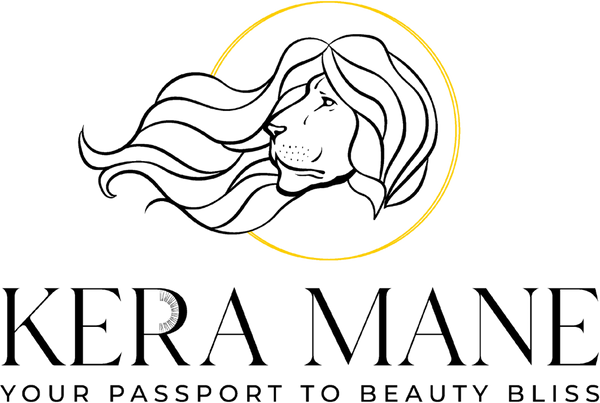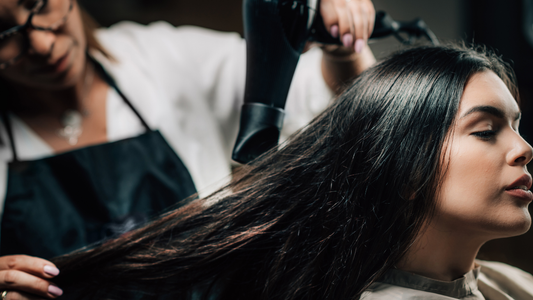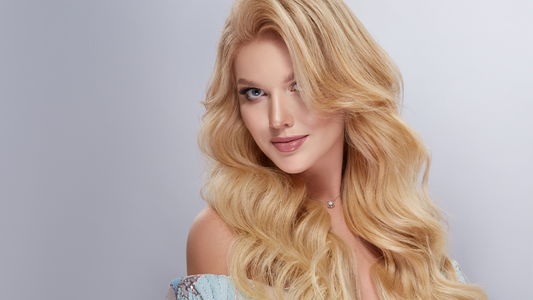In the world of hair care, keratin treatments are a popular solution for transforming frizzy, damaged hair into sleek, smooth, and manageable locks. However, going to a salon for a professional keratin treatment can be expensive and time-consuming. This has led many people to explore the growing market of DIY keratin treatment kits, which allow you to achieve salon-quality results from the comfort of your own home. But how safe and reliable are these at-home kits, and what should you know before using one—especially if it includes purple-tinted formulas designed for color-treated hair?
In this blog, we’ll explore the safety and effectiveness of DIY keratin treatment kits, the unique properties of purple-tinted formulas, and how to ensure you’re using a high-quality, safe product. We’ll also highlight how Kera Mane Keratin Hair Treatment delivers reliable, salon-quality results with a formaldehyde-free, natural formula, perfect for at-home use.
Why DIY Keratin Treatment Kits Are So Popular
At-home keratin treatments have surged in popularity for a number of reasons. Here are a few key benefits that make DIY kits appealing:
- Cost Savings: Salon keratin treatments can be pricey, often costing several hundred dollars. DIY kits provide a more affordable option for people who want the benefits of keratin treatments without the hefty price tag.
- Convenience: DIY kits allow users to apply the treatment at their convenience, in the comfort of their own home. This eliminates the need for scheduling appointments and spending hours at the salon.
- Control Over the Process: With an at-home kit, users have full control over the process, which can be a great option for those who are familiar with their own hair’s needs.
Despite these advantages, there are important safety concerns and reliability issues to consider before using an at-home keratin treatment kit.
Safety Considerations for DIY Keratin Treatment Kits
While DIY keratin treatment kits offer convenience and affordability, it’s essential to be aware of the potential safety risks associated with using these products, especially when applied at home without professional supervision.
1. Ingredient Concerns
-
Formaldehyde Risks: One of the most significant concerns with DIY keratin kits is the potential presence of formaldehyde. This chemical is used in some traditional keratin treatments to provide long-lasting straightening effects. However, formaldehyde poses serious health risks, including respiratory problems, skin irritation, and even cancer. Many at-home kits may claim to be formaldehyde-free, but it’s crucial to check the ingredient list to ensure the product doesn’t contain formaldehyde-releasing agents like methylene glycol or formalin.
-
Sulfates and Harsh Chemicals: Some DIY kits include sulfates or other harsh chemicals that can strip the hair of its natural moisture and damage the hair over time. If you have color-treated or chemically processed hair, it’s especially important to look for a sulfate-free formula to avoid fading your color and weakening your hair structure.
-
Allergen Warnings: Always check for potential allergens in the ingredients list. If you have sensitive skin or scalp conditions, you’ll want to avoid products containing irritants or fragrances that could cause adverse reactions.
Kera Mane’s Approach: Kera Mane Keratin Hair Treatment is completely formaldehyde-free and made with gentle, natural ingredients like plant-based keratin, argan oil, and coconut oil. Our formula ensures that you get smooth, frizz-free results without exposure to harmful chemicals, making it safe for all hair types, including color-treated and sensitive scalps.
2. Proper Ventilation
- Why Ventilation Matters: One of the risks with DIY keratin treatments, especially those containing formaldehyde or harsh chemicals, is the release of fumes when heat is applied. This can occur during the blow-drying or flat-ironing steps. Inhaling these fumes in an enclosed space can cause respiratory irritation, eye burning, or even dizziness.
- At-Home Safety Tips: If you’re using an at-home keratin treatment that contains chemicals like formaldehyde or glyoxylic acid, make sure to work in a well-ventilated area. Open windows, use fans, and take breaks if you experience any discomfort.
Kera Mane’s Approach: Kera Mane’s formula is formaldehyde-free, so it doesn’t release harmful fumes during application. This makes it a much safer option for at-home use, reducing the need for extra precautions such as heavy ventilation.
3. Patch Testing for Allergic Reactions
- Why Patch Testing Is Important: Just like with any other hair care or skincare product, it’s important to perform a patch test before using a DIY keratin treatment kit. This ensures that you won’t have an adverse reaction to any of the ingredients.
- How to Patch Test: Apply a small amount of the product to the inside of your elbow or the back of your neck. Wait 24-48 hours to see if any redness, itching, or irritation occurs. If your skin reacts, it’s best to avoid using the product.
Kera Mane’s Approach: Kera Mane’s natural ingredients, including plant-based keratin, are designed to be gentle on the hair and scalp, reducing the likelihood of irritation. However, we always recommend a patch test for those with sensitive skin or allergies to ensure a safe application.
Are Purple-Tinted Keratin Treatments Safe for Color-Treated Hair?
Purple-tinted keratin treatments are specifically designed for people with blonde, silver, or highlighted hair. The purple tint works similarly to purple shampoos and conditioners, neutralizing unwanted yellow or brassy tones in lightened hair. However, before using a purple-tinted keratin treatment, it’s important to consider a few factors regarding its safety and efficacy.
1. Why Purple Tints Are Used
- Neutralizing Brassiness: Purple-tinted formulas contain violet pigments that counteract the yellow tones that can appear in blonde or gray hair. This helps maintain a cool, bright color, especially for those who have bleached or highlighted their hair.
- Color Protection: Some purple-tinted keratin treatments are designed to protect color-treated hair by creating a barrier that shields the hair from environmental stressors, UV rays, and chemical damage, all of which can contribute to color fading.
2. Safety of Purple-Tinted Keratin Treatments
- Color-Safe Ingredients: Not all keratin treatments are suitable for color-treated hair. Purple-tinted products are generally safe as long as they don’t contain harsh chemicals like sulfates or formaldehyde, which can strip away color and weaken the hair’s structure. Look for sulfate-free formulas to ensure the treatment won’t damage or fade your hair color.
- Hydration and Moisture: Lightened hair is often more fragile and prone to dryness, so it’s important that any keratin treatment you use includes moisturizing ingredients. Purple-tinted treatments with natural oils like argan oil or coconut oil can help nourish and protect color-treated hair while maintaining its vibrant hue.
Kera Mane’s Approach: While Kera Mane doesn’t use purple pigments, our keratin treatment is safe for color-treated hair. It’s formulated with plant-based keratin and natural oils that hydrate and protect color, helping to maintain the integrity and shine of your hair without stripping its color.
Tips for Safely Using DIY Keratin Treatment Kits
If you’ve decided to try a DIY keratin treatment at home, here are some essential tips to ensure you get the best results safely:
-
Choose a Formaldehyde-Free Formula: Always opt for a formaldehyde-free keratin treatment to reduce the risk of inhaling toxic fumes and to protect your hair and health. Look for trusted brands like Kera Mane that use safer, natural ingredients.
-
Follow the Instructions Carefully: DIY kits often come with detailed instructions on how to apply the treatment. Follow these instructions closely, especially when it comes to the timing of the treatment and the use of heat (blow-dryer and flat iron). Overheating or leaving the product on for too long can damage your hair.
-
Use Proper Ventilation: Even with formaldehyde-free products, it’s a good idea to apply the treatment in a well-ventilated area to ensure you’re comfortable during the process.
-
Moisturize and Protect Your Hair Post-Treatment: After applying a keratin treatment, use sulfate-free shampoos and conditioners to prolong the results and maintain the smoothness. Additionally, using hair masks or oils can help keep your hair hydrated and healthy.
-
Avoid DIY Kits with Harsh Chemicals: If you have chemically treated, bleached, or damaged hair, avoid keratin treatments that contain sulfates, parabens, or alcohols. These ingredients can cause further damage to your hair.
Why Choose Kera Mane for At-Home Keratin Treatments
Kera Mane Keratin Hair Treatment is specifically designed to provide salon-quality results in the safety and comfort of your home. Our formula is:
- Formaldehyde-Free: No harsh chemicals or toxic fumes, making it a safer option for at-home use.
- Enriched with Natural Oils: Argan oil and coconut oil provide deep hydration and enhance shine, making it ideal for all hair types, including color-treated hair.
- Plant-Based Keratin: Our keratin is derived from natural sources, offering all the strengthening benefits without animal-derived ingredients.
- Safe for Color-Treated Hair: Kera Mane is sulfate-free, so it won’t strip or fade your hair color. It’s designed to smooth and nourish your hair while protecting your color.
Conclusion
DIY keratin treatment kits offer an affordable, convenient alternative to salon treatments, but it’s important to prioritize safety and quality when choosing a product. Avoid formulas that contain formaldehyde or harsh chemicals, and always perform a patch test before full application.
With Kera Mane Keratin Hair Treatment, you can confidently achieve smooth, frizz-free hair at home without sacrificing safety or hair health. Our formaldehyde-free, plant-based formula ensures that your hair remains strong, shiny, and healthy, whether you have natural or color-treated hair.




